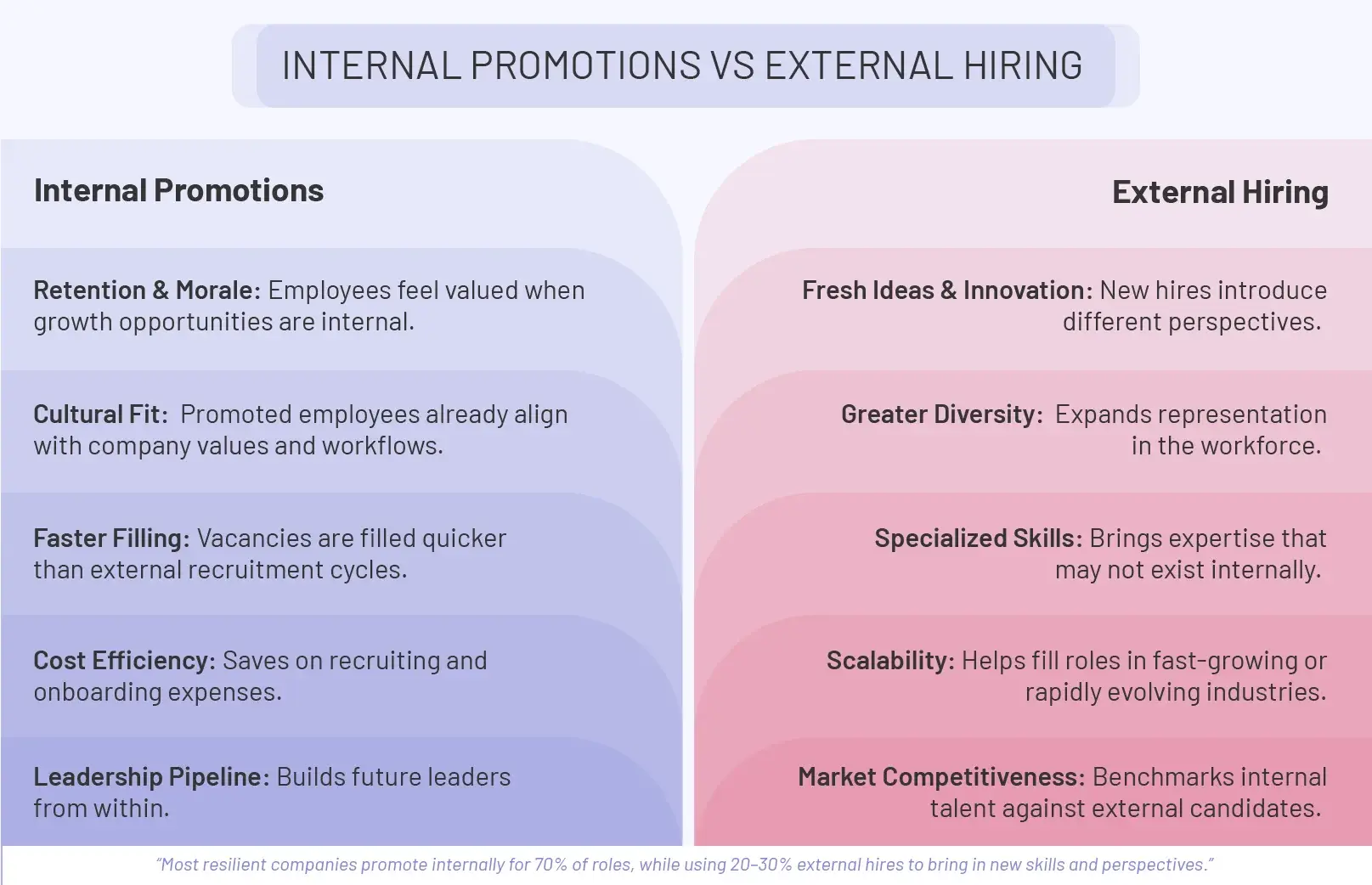Your best performers are leaving for "better opportunities" elsewhere. Meanwhile, you're spending thousands on external recruiters to fill senior roles.
A well-designed internal promotion process transforms this dynamic entirely. It creates visible career paths, motivates performance, and builds a leadership pipeline from people who already understand your business. More importantly, it demonstrates that your organization genuinely invests in employee development, not just rhetoric about "growing our people."
This guide provides a complete framework for building an internal promotion system that actually works. We'll cover how to align promotions with business needs, establish transparent criteria that everyone understands, create fair evaluation processes, and support newly promoted employees through their transition. You'll also learn how to balance internal development with strategic external hiring to maintain both continuity and fresh perspectives.
An internal promotion plan is a structured framework that organizations use to advance existing employees into higher positions within the company. Rather than defaulting to external recruitment, this systematic approach identifies, evaluates, and develops current talent for increased responsibilities and leadership roles.
A well-designed internal promotion plan goes beyond simply filling vacancies. It creates clear pathways for career advancement, establishes objective criteria for progression, and ensures promotions align with both employee capabilities and organizational needs. According to a 2025 SHRM article, 70% of HR practitioners indicate that employee engagement and retention depend on internal mobility opportunities, highlighting the critical role these plans play in talent management.
Core components of an internal promotion plan include:
Promoting from within not only boosts employee morale but also strengthens organizational continuity and drives long-term success.
Here’s a breakdown of the key benefits:
To maximize these benefits, integrate promotion practices into a broader talent management strategies that nurtures career development and aligns with organizational needs.
Creating a structured internal promotion plan for HR requires a strategic approach to ensure fairness and alignment with business objectives.
An effective internal promotion system must include:
Below are six essential steps to guide human resources in building an effective process:

Promoting someone simply because they excel in their current role is one of the most common, and costly, mistakes organizations make. Every promotion should fill a genuine business need, address a skills gap, or advance strategic objectives.
This means looking beyond individual performance to consider where your organization is heading and what capabilities you'll need to get there.
How to Achieve This:
Nothing destroys team morale faster than the perception that promotions are based on favoritism rather than merit. A clear promotion policy builds trust and minimizes perceptions of favoritism. Beyond optics, agreeing on a transparent promotion criteria also sets a roadmap for employees to strive towards, actually impacting performance and boosting engagement.
How to Achieve This:
The gap between what employees imagine a promoted role entails and its actual responsibilities is often wider than intended. Vague role descriptions leave candidates guessing about expectations, making it impossible to prepare adequately.
How to Achieve This:
Even the best promotion criteria mean nothing if the evaluation process itself is flawed. There are plenty of different types of biases that can creep into your internal promotion process unintentionally. A structured evaluation process with multiple stakeholders not only improves decision quality but also protects the organization from accusations of discrimination or favoritism.
How to Achieve This:
Promotion opportunities go to waste if your internal talent aren't aware of them. Broadcast job opportunities for internal candidates the way you would for any other external candidate. Communicating opportunities publicly also creates healthy competition that raises performance standards across the board as employees work toward a clearly communicated opportunity.
How to Achieve This:
The skills that earned someone a promotion rarely translate directly to success in the new role. Especially if the individual is moving from individual contributor to manager. Post-promotion support determines whether your investment in internal talent pays dividends or actually ends up doing more harm than good by burning out the newly promoted employee and discouraging others from seeking advancement.
How to Achieve This:

The decision on whether to internalize or outsource should be based on the needs of the organization. Developing internal talent is effective in industries that can be stable, where there is a concern about transferring knowledge and maintaining the organizational culture.
Conversely, recruiting external candidates will introduce new ideas, which will be useful in rapidly evolving industries or cases where the organization has to increase diversity. Recruitment must also be done outside when the skills cannot be sourced internally.
Many companies use a mix of both approaches to get the best results:
This approach builds a resilient workforce while fostering career development and innovation.
The internal promotions process is not merely an avenue to cover job positions. Rather, it is the promise to develop skills and focus on employee interests within the organization.
HR can develop a culture within which employees could feel appreciated and encouraged by transparent promotion rules, professional growth encouragement, assistance, internal growth retention, and external hiring balance.
In addition to motivating workers, this career path model is the key to the long-term success of organizations since it creates and develops high-potential employees and a well-knit team.
An all-in-one performance management tool for Microsoft Teams
